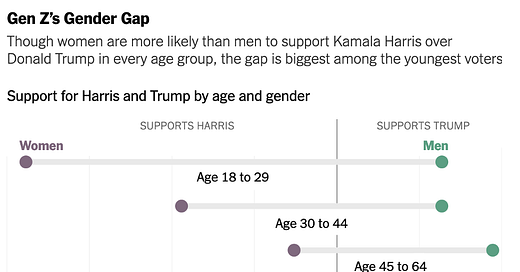One of the worst things about being a writer who tends towards longform essays (and a rather slow and unproductive one at that) rather than Twitter-ready takes is the fear that by the time you manage to cobble an article together, the subject will no longer be relevant. This was certainly the case for my 2020 article on “superfluous men”. I’d been following the subject of incels since 2015, and after a couple of major news headline events that could have served as a hook (like the 2018 Toronto van attack) had come and gone, I was afraid the topic was no longer fresh.
Fortunately for me (and unfortunately for the rest of the world), I turned out to be quite wrong. If anything, my article had come too early. Five years down the line, the number of explicitly incel-motivated terror attacks has steadily grown, and in the wake of the 2024 election’s gender-skewed poll numbers came a plethora of articles asking “what’s the matter with men?”
In my article I had set out to answer this question by explaining that incels were not a bizarre fluke of modern society, but part of a transhistorical category of ‘superfluous men’ - those unable to secure a mate and start a family - that has served as both a useful reserve of expendable manpower and a destabilizing threat to the social order. And it would make sense that as the former aspect has declined with the ‘feminization of labor’ and the general disappearance of large-scale warfare and colonization projects, the latter has come to the forefront. Viewed this way, incels would be only the extreme tip of an iceberg that includes the bulk of the prison population, the members of nationalist mobs and street gangs, and the migrant men who arouse such hostility and suspicion in the countries they enter.
It turns out that I was more correct in this analysis than I realized. What has happened in the last five years is that incel discourse previously confined to the 4chan fringes has metastasized into the mainstream, as the Vice President of the United States pontificates about ‘childless cat ladies’ and how no-fault divorce and its consequences have been a disaster for the human race. This has been accompanied by a general convergence and homogenization of what was dubbed the ‘manosphere’. In 2019, Trump voters, anti-vaxxers, Jordan Peterson acolytes, white nationalists, Andrew Tate fans, crypto enthusiasts, groypers, Joe Rogan listeners, tradcaths, trade protectionists, Tesla drivers, and divorced dads were distinct categories of people who would not have seen themselves as having much in common, and may have even been mutually hostile. Today, they are all the same Type of Guy with the same set of talking points and the same constellation of perceived enemies. That constellation has a face, and it is that of a single young female professional dancing in an office on TikTok. When I implied towards the end of my article that the different categories of surplus men might do well to recognize the common structural factors underpinning their alienation, this wasn’t quite what I had in mind.
In any case, despite all the calls for a new masculinity or a ‘Joe Rogan of the left’ I don’t foresee this problem being resolved. Aggrieved and disenfranchised men are not a bug but a feature of how class society produces and manages surplus masculinity - a kind of ‘accursed share’ whose destructive power, when not directed outward, will turn upon its own.





Glad to see this article and substack. Just wondering if you or any of your readers saw the series Adolescence. Also I think this topic is super relevant to the culture we are living in right now seeing it grow ...
with Microsoft laying of 3% of its workforce, and headlines like these: "Laid-Off Metaverse Engineer Says He Is DoorDashing and Living in a Trailer" becoming the norm - this topic seems here to stay